In this section, we're going to focus in on how to write emails so they get opened, read, and acted on, but in the right way. In a way that supports and develops your brand and deepens your relationship with your audience.
You may have heard it said that "the money is in the list" or as Jeff Walker says, your list means "money on demand." And that's true in many respects.
When you capture someone's email address on your site, you have the opportunity to transform a one-time visitor into a follower, a fan, a customer and even a repeat customer or partner.
Why? Because research shows that it takes 5-7 impressions to "stick" in someone's mind. It also usually takes 5-7 impressions before a new subscriber is willing to pull out a wallet and buy.
The challenge is that these days, your tribe's inbox is a pretty crowded place.
We're all bombarded every single day with dozens of marketing messages -- and we ignore the vast majority of these messages. Half the time we don't even open them.
We choose to open emails for just 1 of 2 reasons:
- The subject line of that email grabs us and inspires to open. We're curious about what's inside, or...
- We know, like, and trust the person who has sent the email
Let's talk about subject lines and give you a few case studies
The SINGLE and ONLY job of an email subject line is ... what?
Right -- its ONLY job is to get the email opened. So many people try to accomplish too much with their subject line and the poor thing fails at all of it. But when you focus on just getting the email opened, your job really simplifies doesn't it?
Now I'm going to go into the 8 best ways to get your email subject lines opened, read and acted on.
1. The "Question" Subject Line

Questions make great email subject lines because they get the reader to think about how the subject matter applies to their own life. The best questions will resonate with the reader and their past experiences, while arousing a sense of curiosity to learn more about the subject and whether their experiences are similar to others.
For example:
- Are you joining us?
- What's your take on this?
- "Are you a robot?"
These subjects lines work because they raise curiosity and because questions demand answers, the reader almost MUST click through to get closure. I don't know about you, but there's no way in hell I could leave that last one unopened. I would need to know if I'm secretly a robot.
And in case you're curious, the answer turned out to be "no." Phew.
2. The "How To" Subject Line
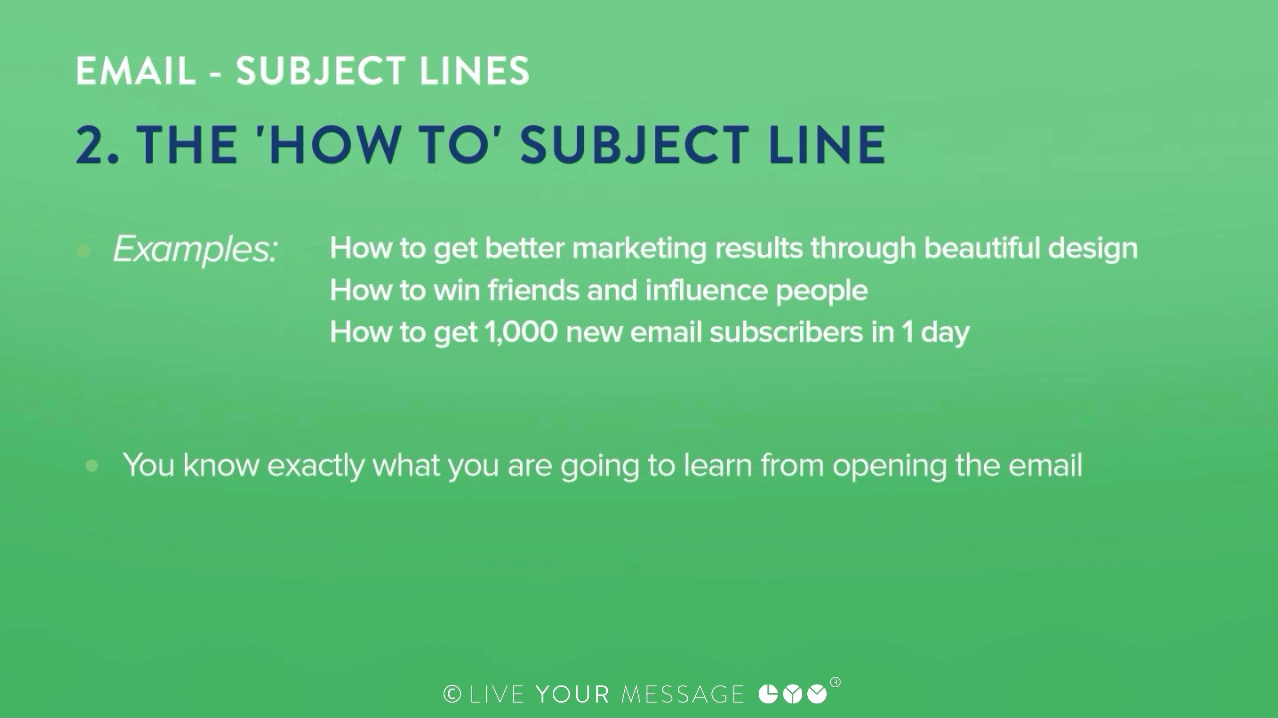
There's an old saying in copywriting circles that you can't write a bad headline if it starts with the words 'How to'.
The 'How to' subject line formula works so well because it forces you to describe the content of the email in very clear language.
Take these 3 subject lines for example:
- How to get better marketing results through beautiful design
- How to win friends and influence people
- How to get 1,000 new email subscribers in 1 day
By reading these subject lines, you know exactly what you are going to learn from opening the email. The key to success with this subject line formula is focusing on the benefit. Nobody actually wants to learn another process or methodology, instead they want to get the end benefits of better marketing results or new email subscribers, so make sure when using a 'How to' subject line you focus on the benefits and not the process itself.
3. The "Scarcity" Subject Line

Scarcity is a powerful driver of human behavior. When something is in short supply, our fear of missing out kicks in and we are compelled to act. Adding a time or availability limitation encourages readers to open and act on your email before it's too late. For example:
- Final day to join B-School until next year
- Find out if you should attend TODAY
- 2 F.REE Books - This Week Only!
The key to using scarcity in your email subject lines is importance. If the reader doesn't have any intention of purchasing from you, they are not going to care that they can get free shipping if they purchase in the next hour.
You need to make sure the offer you are presenting is important to the reader before you bring scarcity into it to try to compel them to act quicker, otherwise the time or availability limitation you are imposing is irrelevant to them.
4. The "Announcement" or "Newsy" Subject Line
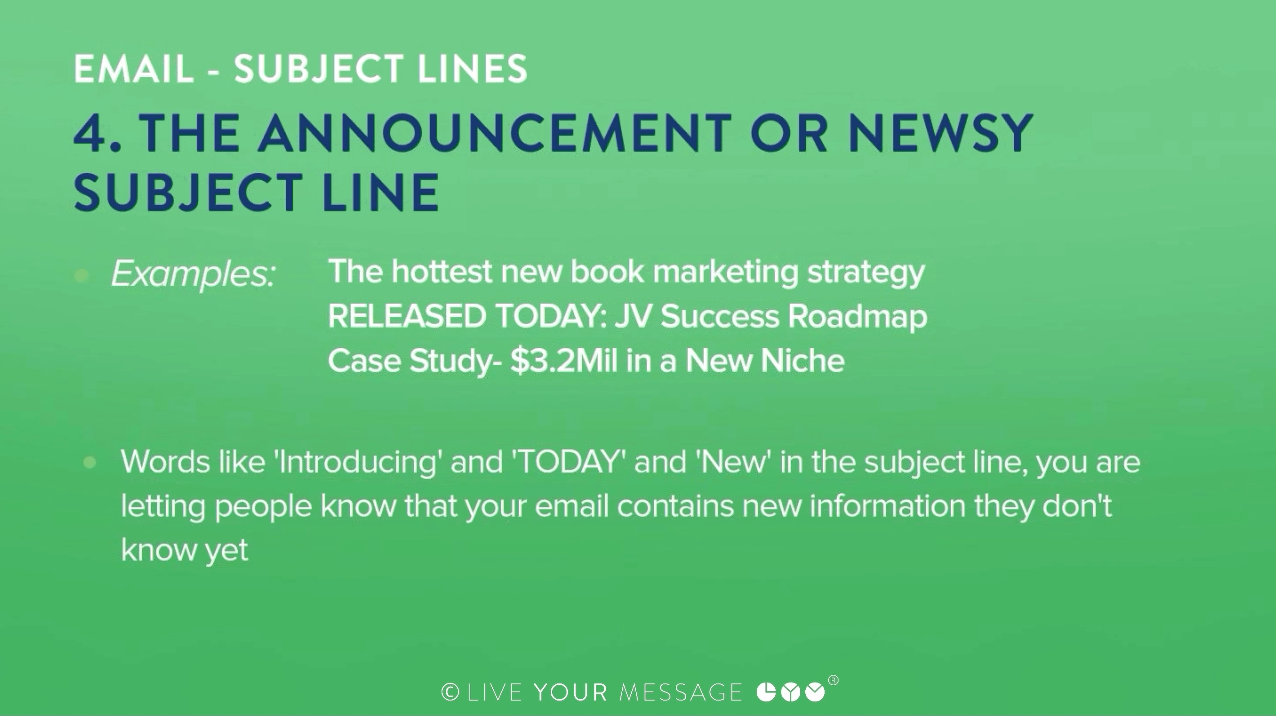
Using words like "Introducing" and "New" in your email subject line gives the reader a feeling that your email contains new, breaking information they haven't heard yet.
In our recent study on power words in email subject lines, email subject lines that included terms like 'Introducing' and 'New' increased the chance of the email being opened by 9.45% and 3.26% respectively.
Examples of this formula in action include:
- The hottest new book marketing strategy
- RELEASED TODAY: JV Success Roadmap
- Case Study- $3.2Mil in a New Niche
By using words like 'Introducing' and 'TODAY' and 'New' in the subject line, you are letting people know that your email contains new information they don't know yet and are encouraging people to open the email and learn more.
5. The "Number" Subject Line
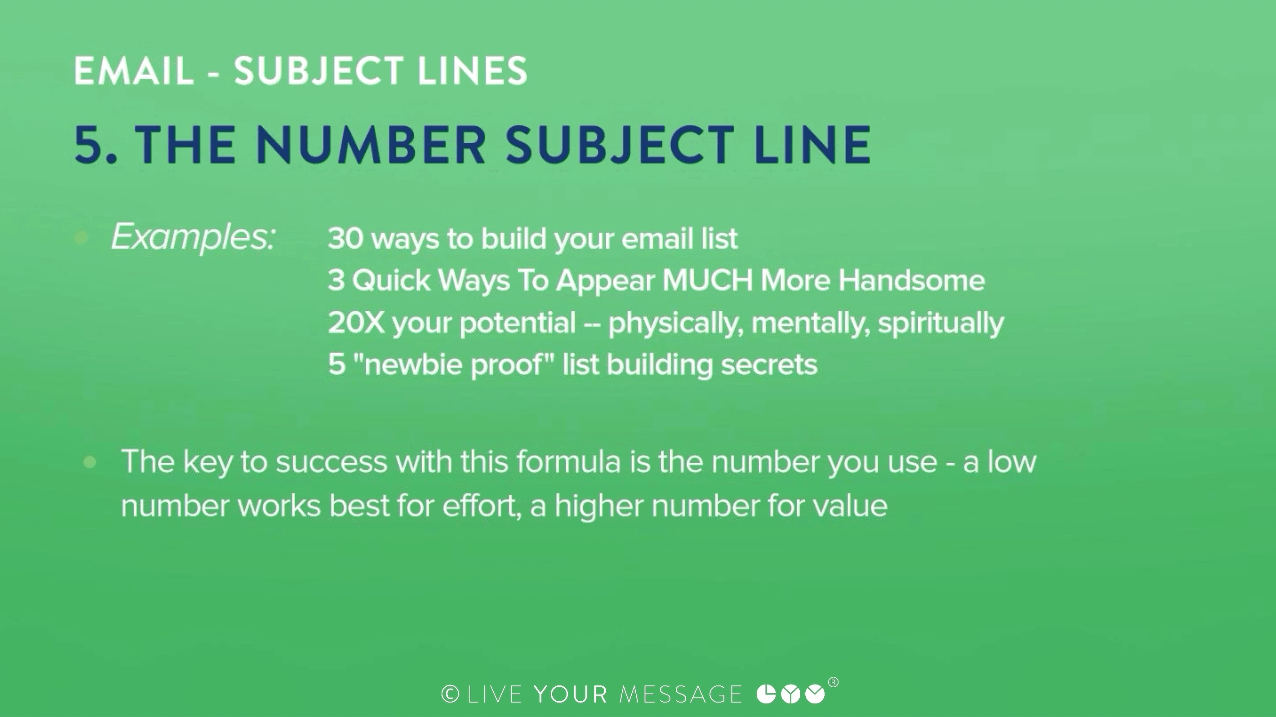
Using numbers in your email subject lines is a great way to set people's expectations and provide a structure for the content of your email.
Every time we do any kind of A/B testing of our blog post headlines, we find that the version of the headline containing the number outperforms the one that doesn't. So where possible and where it makes sense, use numbers to make your subject line more specific.
For example:
- 30 ways to build your email list
- 3 Quick Ways To Appear MUCH More Handsome
- 20X your potential -- physically, mentally, spiritually
- 5 "newbie proof" list building secrets
The key to success with this formula is the number you use. If you are suggesting effort a reader needs to expend (like steps in a process for instance), then using a low number works better as it suggest the process is quicker and easier. However, if you are providing value to the reader (like a number of ways to increase email subscribers) then a higher number will work better as it increases the reader's perception of the value your email will provide them.
6. The "Surprise" Subject Line
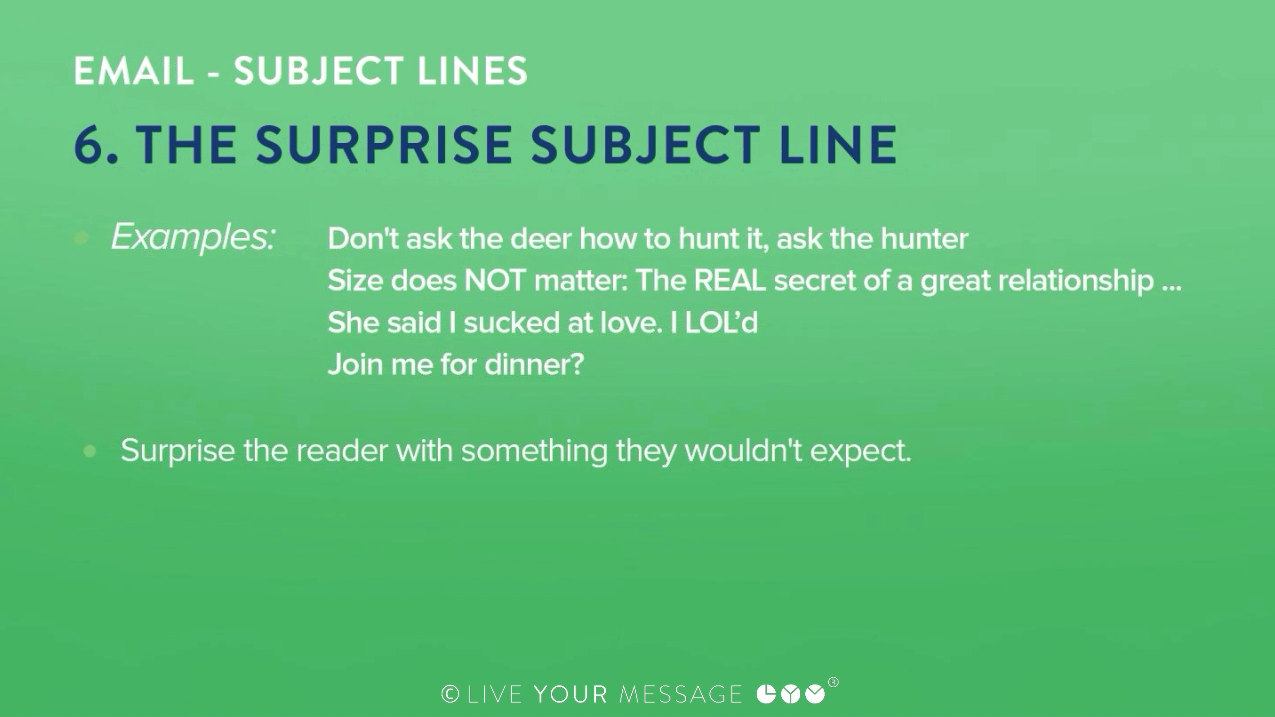
Everybody loves a good play on words or a pleasant surprise.
In fact, studies on brain activity show that these unexpected occurrences light up the pleasure centers of the brain. Whether it's a small chuckle or an unexpected offer that benefits the user, using surprise in your subject line causes the reader to pause while scanning through their inbox and piques their curiosity enough to open the email and learn more.
Some examples include:
- Don't ask the deer how to hunt it, ask the hunter
- Size does NOT matter: The REAL secret of a great relationship ...
- She said I sucked at love. I LOL'd.
- Join me for dinner?
The key here is not so much to use a specific formula, but just to surprise the reader with something they wouldn't expect.
In fact, during Barack Obama's presidential election campaign his team used the subject line 'Join me for dinner?' in one of their email campaigns. Whilst 'Join me for Dinner' is certainly not a surprising subject line, the fact that it came from the President of the United States certainly surprised a few people.
7. The Personalized Subject Line
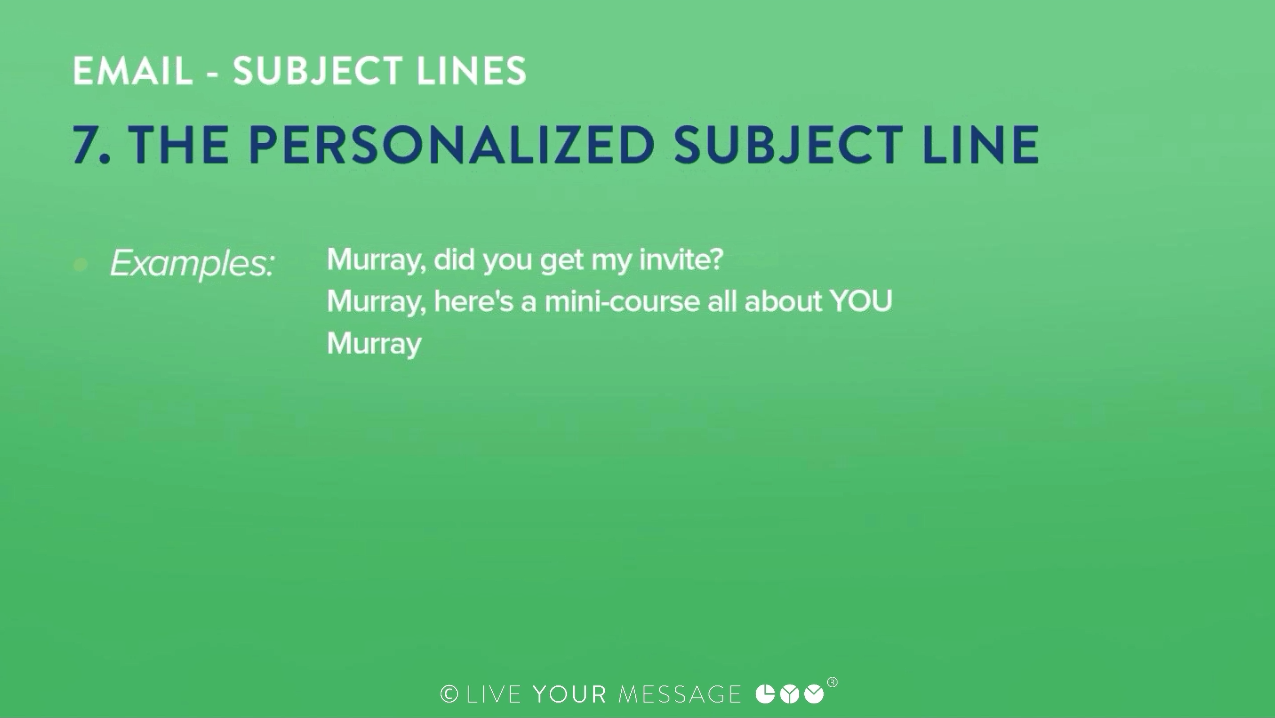
Working your subscriber's name into the subject line of your email adds a personal touch that is likely to catch your reader's eye.
Any time you can make your reader feel like you're connecting with them on a very personal level, it builds a sense of sincerity. In fact, in our recent study on power words in subject lines we found that using the recipients first name in the subject line increased the chance of the email being opened by 14.68% .This can be combined with some of the other formulas for maximum impact. For example:
- Murray, did you get my invite?
- Murray, here's a mini-course all about YOU
- Murray
Famous internet marketer Frank Kern has a well-publicized hankering for using just his subscribers first name as the entire subject line. Nothing else! He swears by all that's holy that it has huge open rates.
And I have to say - every time we've tried it, it's done OK.
8. The "Curiosity Gap" Subject Line

Viral websites like Buzzfeed have built publishing empires off the back of a psychological phenomenon known as the "curiosity gap."
Professor George Loewenstein coined this term to describe the gap between what we know and what we want to know. When we notice a gap in our knowledge, it produces a feeling of deprivation that prompts us to go looking for that piece of missing information in order to stop feeling deprived.
However, curiosity requires a little bit of initial knowledge first. We're not curious about something we know absolutely nothing about. However, as soon as we know even a little bit, our curiosity is piqued and we want to learn more. So try leaving a small curiosity gap in your subject lines to encourage opens.
- Well... this failed miserably
- Whoa
- The big lie...
- Lee launched his first product EVER (results inside)
As the famous novelist Anton Checkhov wrote, "If you say in the first chapter that there is a rifle hanging on the wall, in the second or third chapter it absolutely must go off. If it's not going to be fired, it shouldn't be hanging there."
What each subject line does is create an open loop that gets closed in the body of the email. Another way to put it is that they start a story in the subject line that's continued and (and finished) in the email.
"Open loops" is the dramatic principle that creates books you can't put down, emails you're compelled to open and products you're inspired to buy.
More examples of open loops in action:
To help you put this into practice, I've pulled some more examples from my inbox and analysed how these have been made effective using open loops.
SUBJECT: What Bruce Lee can teach you about design
Fast Company did a great job of incorporating the open loops technique into this subject line.
Being a design-focused publication, their subscribers are interested in learning about design so they use that as the hook to show the reader this is information they want, while using the Bruce Lee reference to show them what they don't know and establish the information gap that compels people to open the email.
SUBJECT: This little known copywriting formula can increase your email click-through rate
We tend to mix it up at LYM - and we're just as likely to send inspirational and transformational messages as purely "how to" content, and this subject line was a great hook to show the reader this is information they want, while using the 'little known secret' line to establish what they don't know and create an information gap that compels people to open the email.
It's all about balance when using open loops.
If you've ever seen a story from sites like Upworthy being shared on your Facebook newsfeed, you might recognize this technique at work in their distinctive "This guy started filming his dog. What happens next will shock you" style headlines.
That's an extreme example of the open loop and some folks (me included) find it quite spammy, so it's up to you how far you want to take this experiment.
To sum up -- incorporating the open loops technique into your subject lines can increase your open rates by creating a sense of anxiety that compels people to open your email. I find that keeping it conversational and balanced is the key. If you overuse any technique, your audience will start to become immune to it and eventually it will stop having the desired effect on your readers.
So now, I want you to imagine writing your email subject lines using some juicy open loops that create massive dramatic tension.
Do you think it would make a difference in your open rate? Your conversions? You bet it would.
I'd like you to take a few minutes now and practice writing some email subject lines that will get opened. I'll give you a few minutes and then I'd like to see some of your subject lines in the question box. I'll be reading out the best ones.
Try to write a few in each of the 8 email subject line categories:
- The "Question" subject line
- The "How To" subject line
- The "Scarcity" subject line
- The "Announcement" or "Newsy" subject line
- The "Number" subject line
- The "Surprise" subject line
- The Personalized subject line
- The curiosity gap subject line
The honest truth is that while your email subject line is incredibly valuable, the other half of the puzzle in getting emails opened is your relationship with your tribe.
No matter how awesome your subject lines, if you're delivering junk to their inbox week after week, your open rates are going to drop, and your peeps are going to unsubscribe in droves.
Truly huge open and clickthrough rates are the byproduct of building a relationship over time.
It's a result of how you make your audience feel through the stories you tell and what you share about yourself; it's the result of the value you give through the expertise you offer.
There is no way to shortcut this process. The only way to establish this relationship is to create connection and offer value in every single email you send -- from the very first email you deliver welcoming them into your community, to the second, third, fourth email, and every single email after that -- including your promotions.
Whether you're sending a value email or a promotion, the goal is to build a relationship from the ground up based on familiarity and trust.
